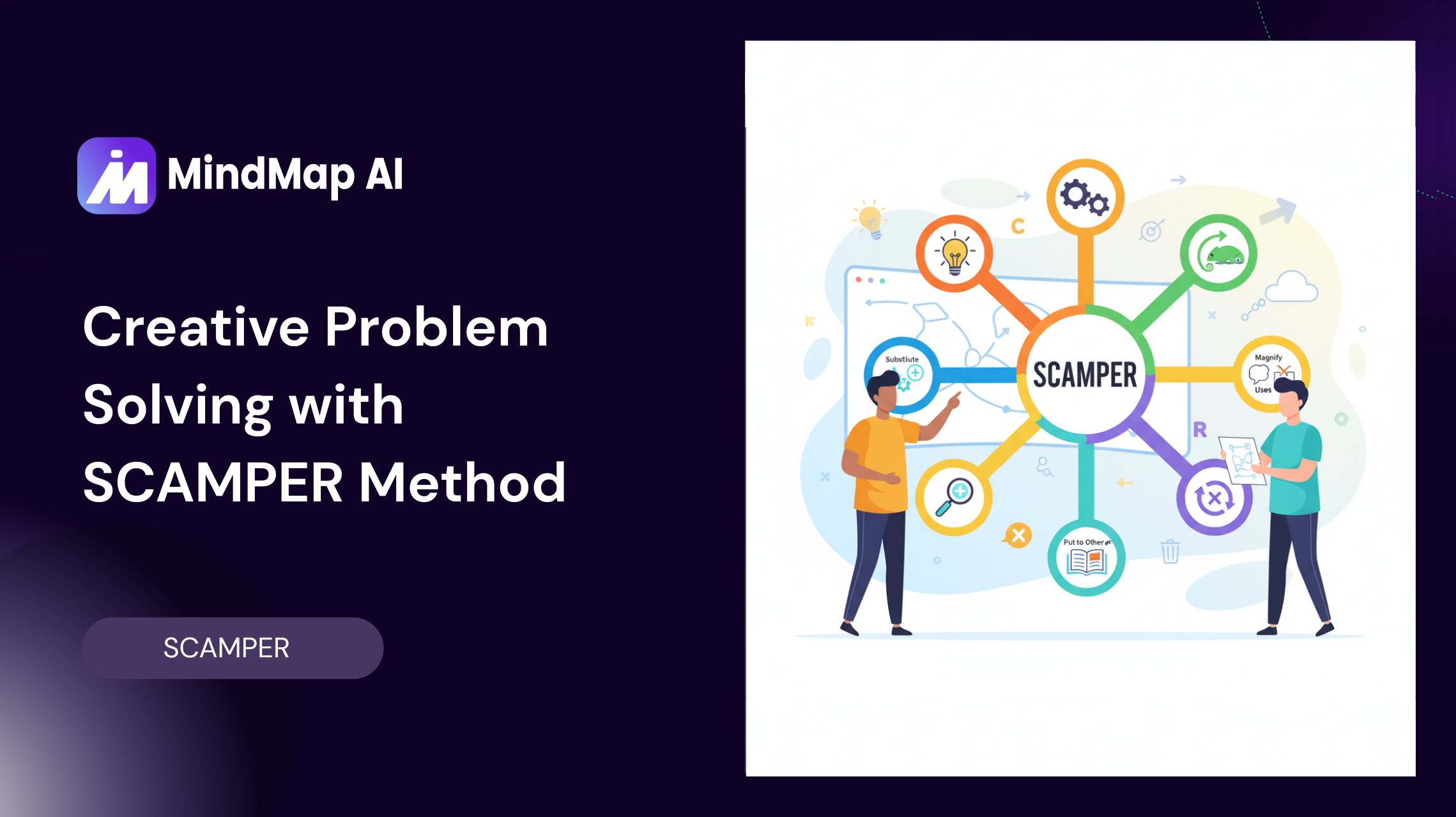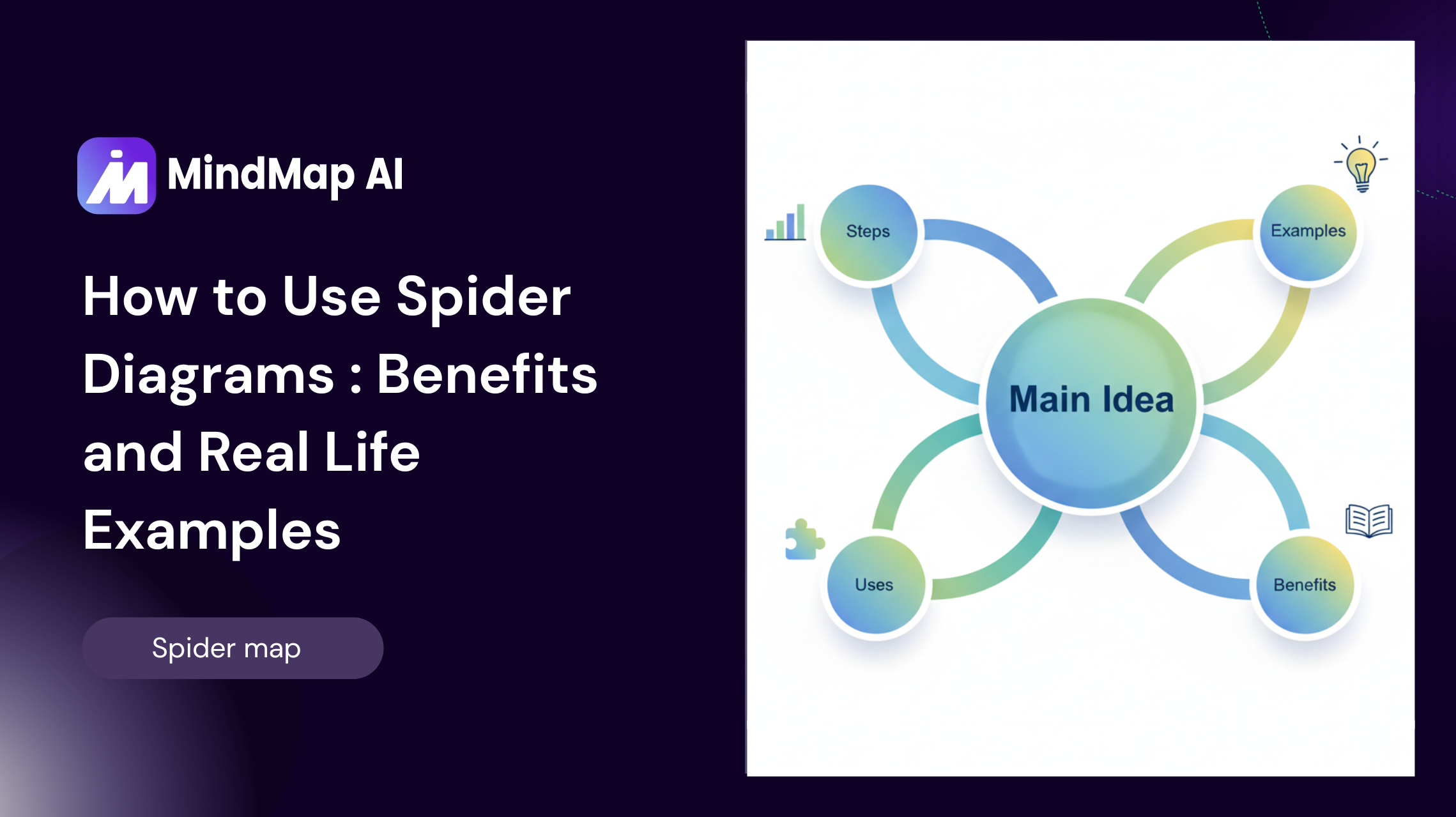
Creative Problem Solving with SCAMPER
Have you ever been stuck on a problem and felt like your brain just won’t give you new ideas? Maybe you had to finish a school project, write a story, or even find a faster way to do your chores. At times like this, we usually think in the same way we always do, and that makes it hard to find fresh solutions.
This is where SCAMPER comes in. SCAMPER is a fun and simple problem-solving method that helps you think differently. Instead of waiting for random inspiration, SCAMPER gives you a set of smart questions that guide your imagination. It’s like having a “creativity checklist” in your pocket that you can use any time you feel stuck.
The best part? SCAMPER isn’t just for businesses or inventors. Kids, students, teachers, and even parents can use it. Whether you want to design a new toy, improve your homework, or make everyday tasks easier, SCAMPER helps you see things in new ways and come up with creative solutions.
SCAMPER Primer

SCAMPER is based on a simple idea: nothing new is truly 100% new. Almost everything we create is just a change or improvement of something that already exists. Think about it, smartphones are upgraded versions of regular phones, pencils become mechanical pencils, and games often come from old games with new twists.
That’s exactly what SCAMPER helps you do. Each letter in the word SCAMPER gives you a different way to play with your problem or idea:
S = Substitute
C = Combine
A = Adapt
M = Magnify
P = Put to Other Uses
E = Eliminate
R = Rearrange (or Reverse)
How Do You Use It?
Using SCAMPER is easy. Just follow two steps:
Step 1: Pick a problem or idea you want to improve.
It could be anything, your homework, a science project, a business idea, or even how to make chores faster.
Step 2: Ask the SCAMPER questions.
Each letter gives you a new type of question. By answering them, you’ll start seeing possibilities you never thought of before.
Examples
1. Business – “How can I increase sales in my shop?”
S (Substitute): “What can I swap in my selling process?”
C (Combine): “Can I combine sales with events or promotions?”
A (Adapt): “What can I copy from other successful businesses?”
M (Magnify): “What can I highlight more—like free delivery or discounts?”
P (Put to Other Uses): “Can I use my shop space for classes or rentals too?”
E (Eliminate): “What steps can I remove to make buying easier?”
R (Rearrange): “What if I change the order like customers pay first, then pick up?”
2. Student – “How can I make my school project better?”
S (Substitute): “Can I replace paper charts with a colorful mind map?”
C (Combine): “Can I mix pictures and text together so it’s easier to understand?”
A (Adapt): “Can I use ideas from a science video or book to improve my project?”
M (Magnify): “Can I make the title bigger or add more details to impress the teacher?”
P (Put to Other Uses): “Can I reuse old drawings or notes from another subject?”
E (Eliminate): “Can I remove boring parts that don’t really help?”
R (Rearrange): “Can I change the order like showing results first, then the steps?”
By running through these questions, you push your brain to explore fresh solutions instead of staying stuck.
A Real Example – McDonald’s
McDonald’s is famous not just for burgers, but for how it used SCAMPER thinking:
Put to Other Uses (P): They sold real estate and restaurants, not just food.
Rearrange (R): Customers pay first, then eat — faster service!
Eliminate (E): They cut out waiters by letting people serve themselves.
These are just a few examples, but they show how small creative changes can make a huge impact. With ideas like these, McDonald’s grew into one of the biggest food chains in the world.
SCAMPER Reference
Below is a practical help guide to using SCAMPER. You’ll find over 100 guiding questions and nearly 300 spark words you can use to trigger fresh ideas. Think of it as your creativity playbook anytime you’re stuck, just pick a question or word and see where it takes you.
1. Substitute
Think about replacing part of the problem, product, or process with something else. Sometimes a simple swap leads to big change. You can switch things, places, people, materials, processes, or even emotions to discover fresh possibilities.
Helper Questions
Can I replace or change any parts?
Can I swap someone involved with another person?
Can the rules or policies be changed?
Can I use different ingredients, materials, or tools?
Can I try another process or method?
What if I change the shape, size, weight, or form?
Can I change the color, texture, sound, or smell?
What if I rename, rebrand, or repackage it?
Can I substitute one part for another (like buttons for touchscreens)?
Can I use this idea in a different place, context, or culture?
Can I change my feelings or attitude toward it?
Can I replace technology with manual effort (or the other way around)?
What if I swapped timing — daytime vs. nighttime use?
Can I replace an expensive element with a cheaper one?
What if I swapped out the audience — children instead of adults, beginners instead of experts?
Can I substitute physical with digital (or digital with physical)?
Trigger Words
swap, switch, replace, exchange, alternate, shift, changeover, flip, switcheroo, proxy, stand-in, surrogate, substitute, rename, rebrand, repackage, repurpose, relabel, remodel, reshape, reposition, rethink, trade, interchange, shift out, fill in for, replacement, temporary, exchangeable, plug-in, variant, stand-by, cover for, alternate version, mimic
2. Combine
Think about merging two or more elements of your problem, product, or process to create something new or enhance its effectiveness. Many breakthrough ideas are born when unrelated concepts are fused together.
Helper Questions
What ideas, parts, or features can I combine?
Can I recombine existing parts for a new purpose?
Can I merge it with another product, service, or tool?
What if I combine physical and digital aspects?
Can I combine different functions into one?
Can I combine efforts across teams or departments?
What materials or technologies can be blended?
Can I combine talent from different fields to improve it?
What happens if I combine traditional methods with modern ones?
Can I combine ideas from different industries or cultures?
Trigger Words
amalgamate, blend, bring together, coalesce, combine forces, commingle, conjoin, cross-pollinate, dovetail, embed, fuse, hybridize, interlace, interlock, intermix, join, link, mash-up, merge, mingle, mix, overlay, package, pair, partner, relate, stack, synthesize, tie together, unite
3. Adapt
Think about how an existing idea, method, or solution can be adjusted to fit your problem. Most innovations are borrowed or inspired by something that already exists, just used in a new way.
Helper Questions
What else is like this?
Is there something similar but in a different context or industry?
Does history or past experiences offer lessons?
What can I borrow, copy, or tweak from others?
Who could I learn from or emulate?
Can I adapt a solution from another culture or field?
Can I adjust the size, shape, or function to suit my needs?
What if I adapt it for a new audience or market?
Can I use the same concept in a digital version (or physical one)?
What ideas from nature can I adapt?
What tools, apps, or technologies can be re-purposed?
Can I adapt it for people with different needs (kids, seniors, disabled)?
What would happen if I slightly modified the rules?
Can I adapt a trend from one industry (e.g., gaming, fashion) into mine?
Trigger Words
acclimatize, adjust, align, alter, amend, bend, borrow, change, conform, contextualize, convert, copy, customize, derive, emulate, evolve, familiarize, fit, imitate, incorporate, innovate, learn from, make suitable, match, mimic, modify, mold, personalize, readjust, reconstruct, refashion, reform, repurpose, reshape, retool, revise, rework, shift, tailor, transform, tweak, vary
4. Magnify
Think about ways to magnify, exaggerate, or enhance your idea. Sometimes making something bigger, stronger, or more noticeable helps you see its hidden potential. Magnifying can also mean duplicating or adding new features to increase value.
Helper Questions
What can be magnified or made larger?
What elements can I exaggerate or highlight more?
What can be made higher, stronger, faster, or more powerful?
Can I increase the frequency or intensity of use?
Can I duplicate or make multiple versions?
Can I add extra features, layers, or details?
What if I stretch the time to make it last longer?
Can I increase the emotional impact (funny, dramatic, inspiring)?
What can be emphasized to grab more attention?
Can I magnify the design to make it more colorful, bold, or eye-catching?
Can I enhance the usability or accessibility for more people?
Can I scale it up for mass use or larger audiences?
What if I combine multiple copies for a bigger effect?
Can I intensify the marketing message or visuals?
What if I zoom in on one part and make it the main focus?
Trigger Words
amplify, augment, boost, broaden, build up, dramatize, duplicate, elaborate, elevate, embolden, emphasize, enlarge, enhance, exaggerate, expand, extend, extend lifespan, extend reach, fortify, grow, heighten, highlight, intensify, lengthen, magnify, maximize, multiply, overemphasize, overstate, prolong, raise, reinforce, spotlight, strengthen, stretch, supercharge, swell, upgrade, widen
5. Put to Other Uses
Think of how you might apply your current idea to different situations, audiences, or industries. Many great innovations come from reusing something in a new way whether that’s a product, a process, or even knowledge from another field.
Helper Questions
What else can this be used for?
Can I use this idea in another field or industry?
Could different audiences (kids, seniors, professionals, hobbyists) use it in their own way?
Can it solve a different problem than the one I originally thought of?
How might someone from another culture or background use it?
What if I take it out of its usual environment — does it still work?
Can I recycle or repurpose waste parts of it?
What byproducts could be used for something new?
Can I take this offline and make it digital or vice versa?
What new purposes emerge if I shrink it? If I enlarge it?
Could it be turned into a teaching tool, an entertainment product, or a social initiative?
How would an expert from another profession (engineer, artist, doctor) use this idea?
Can I reposition it for luxury, budget, or niche markets?
What if I flipped its main use — secondary features become the main product?
Can its data, design, or process be repurposed elsewhere?
Trigger Words
apply, adapt, alternate use, borrow, capitalize, convert, cross-apply, derive, employ, exploit, extend, extract, find new purpose, flip, harness, implement, improvise, innovate, integrate, leverage, maximize, modify, multi-purpose, pivot, recycle, reimagine, reinvent, reposition, repurpose, reuse, shift, source, spin-off, stretch, substitute use, tap into, transform, transfer, translate, turn into, utilize
6. Eliminate (or Minify)
Think of what happens if you remove, reduce, or minimize parts of your idea. Simplification can uncover what’s essential and make your idea easier, faster, or more affordable. Often, the best solutions come from stripping away the non essentials.
Helper Questions
How can I simplify it without losing its core function?
Which parts or steps are unnecessary or redundant?
Can I remove a rule, tradition, or assumption holding this back?
What if I take away the most expensive or complex part—does it still work?
Can I make it smaller, lighter, shorter, or faster?
What happens if I understate or hide a feature?
Can I break it into smaller, independent parts?
What features are rarely used — can I remove them?
Can I remove the “middleman” (steps, people, tools) in this process?
Would eliminating this make it easier to understand or teach?
What if I reduce the cost, size, or time by half?
Can I eliminate waste, packaging, or unnecessary decoration?
Can I limit it to a single purpose instead of many?
What if I strip it down to a “minimum viable version”?
What happens if I do nothing — does the problem disappear on its own?
Trigger Words
abolish, ax, banish, break down, cancel, compress, condense, cut out, curtail, decline, delete, diminish, discard, disentangle, drop, edit, eradicate, exclude, extract, filter, free from, get rid of, lighten, lower, minimize, narrow, omit, pare down, prune, purge, reduce, refine, reject, release, remove, shrink, simplify, slash, streamline, strip down, subtract, throw out, tone down, trim, understate, unload, waste less, wipe away
7. Rearrange (or Reverse)
Think of what would happen if you changed the order, layout, sequence, or direction of your idea. Sometimes simply flipping or reordering things reveals opportunities no one else has noticed. Doing the opposite of what’s expected often sparks bold, innovative solutions.
Helper Questions
What other arrangement might make this simpler or more effective?
Can I swap or interchange the components?
What if I change the order of steps in the process?
Are there different patterns, layouts, or sequences to try?
What happens if I reverse cause and effect?
Can I deliver it earlier, later, or in a different rhythm?
What if I swap roles — what happens if the customer becomes the creator?
Should I turn it upside down, inside out, or backwards?
What if I start from the end and work to the beginning?
What happens if I invert priorities — what was last becomes first?
Can I rearrange the team, tools, or workflow?
What if I try the exact opposite of my original intention?
Can I flip positive/negative, advantage/disadvantage, or risk/opportunity?
What if I break the normal sequence — parallel instead of linear?
Could I reschedule or deliver at a different pace?
What happens if I replace traditional order with randomness?
Trigger Words
adjust, alter, backtrack, change course, convert, flip, interchange, invert, loop back, mirror, modify sequence, move around, overhaul, pivot, rearrange, realign, reorder, reorganize, replace, reposition, reshuffle, restructure, reverse, rotate, shift, shuffle, spin, substitute, swap, switch, transpose, turn around, turn upside down, twist, undo, upend
Conclusion
SCAMPER isn’t just a checklist, it’s a creativity engine. By asking different kinds of “what if” questions, you give your brain permission to explore paths it normally wouldn’t. Whether you’re brainstorming for a business idea, redesigning a product, solving a study problem, or just stuck on a project, SCAMPER gives you a structured way to unlock fresh perspectives.
Think of it as your mental Swiss Army knife, you don’t need all seven tools every time, but even using one or two can spark breakthroughs. The more you practice, the more natural it becomes to shift, combine, adapt, magnify, repurpose, trim, or rearrange ideas in your daily work and life.
So the next time you feel stuck, don’t wait for inspiration SCAMPER your way forward.








